
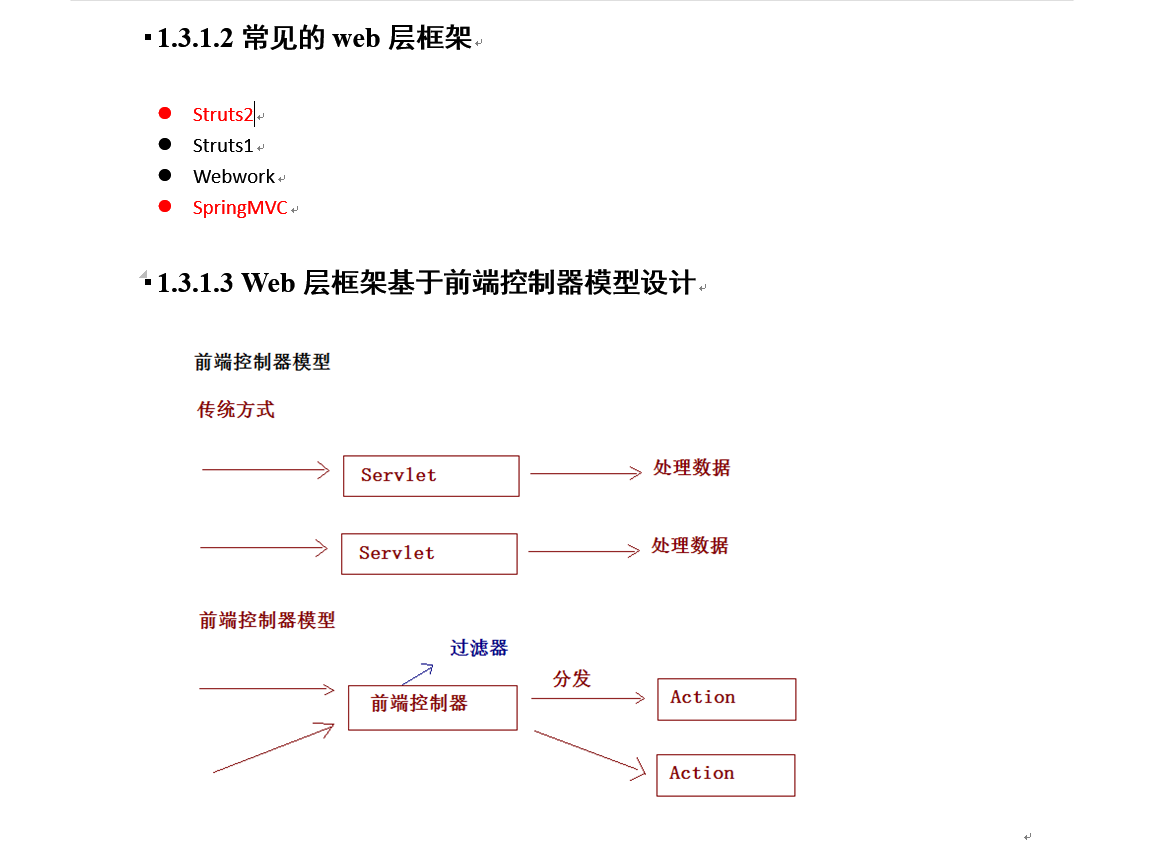

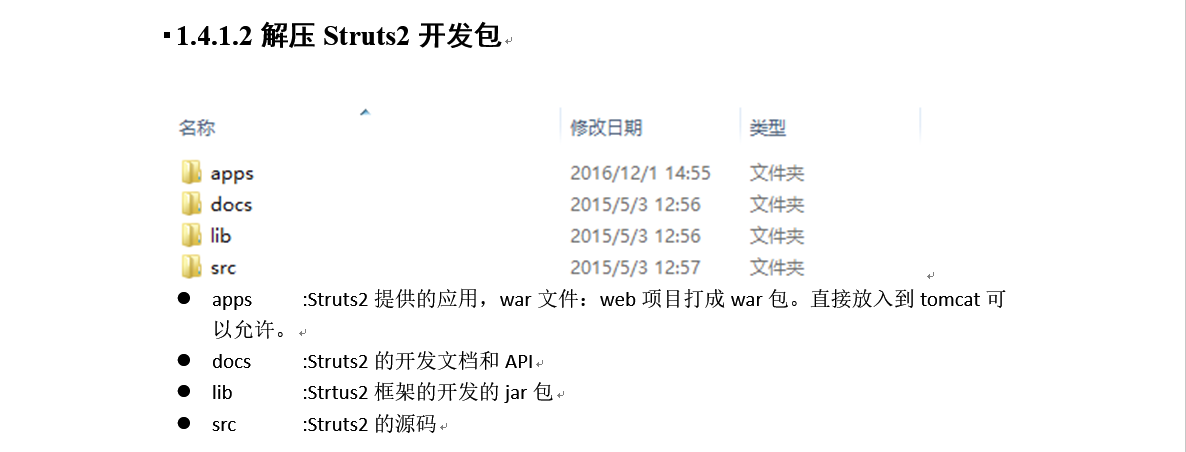
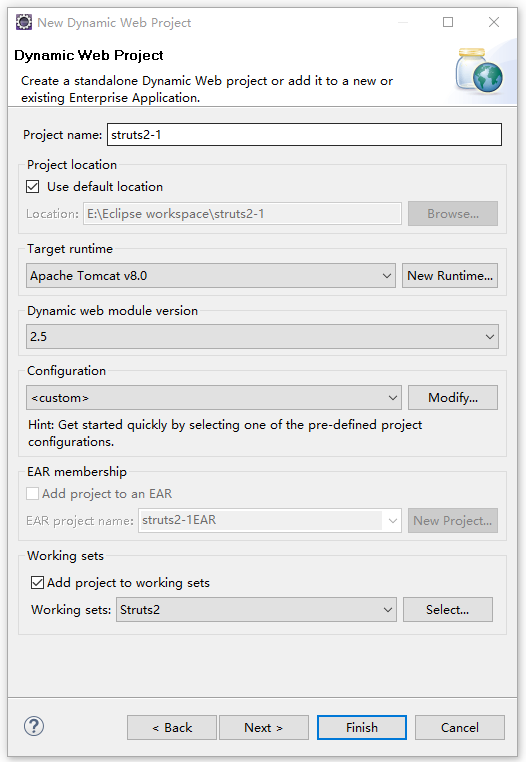
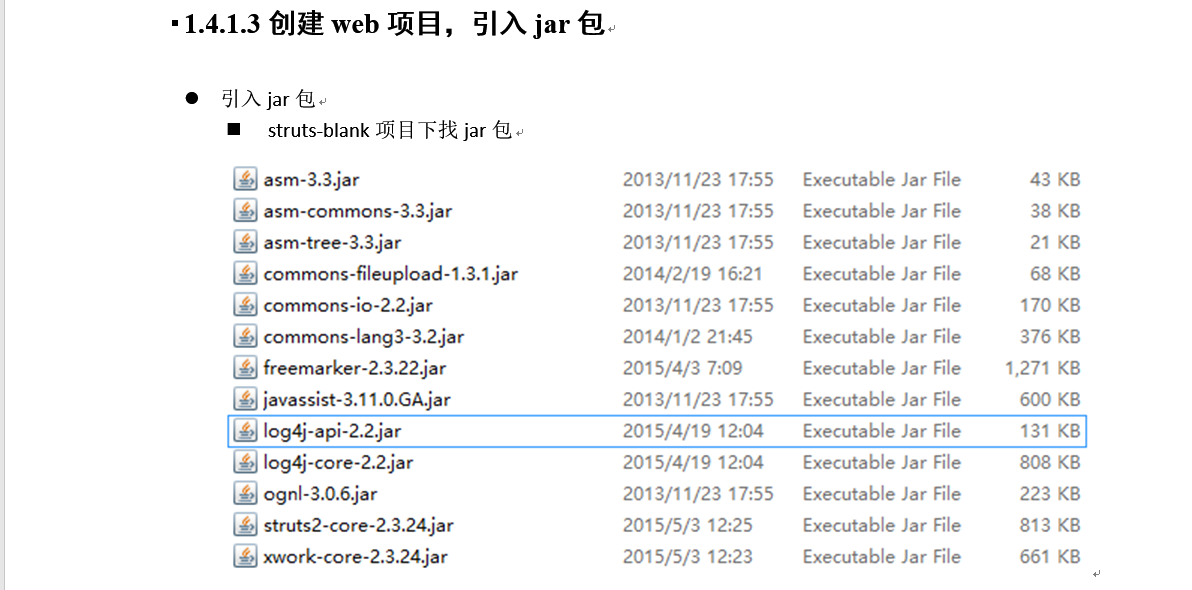




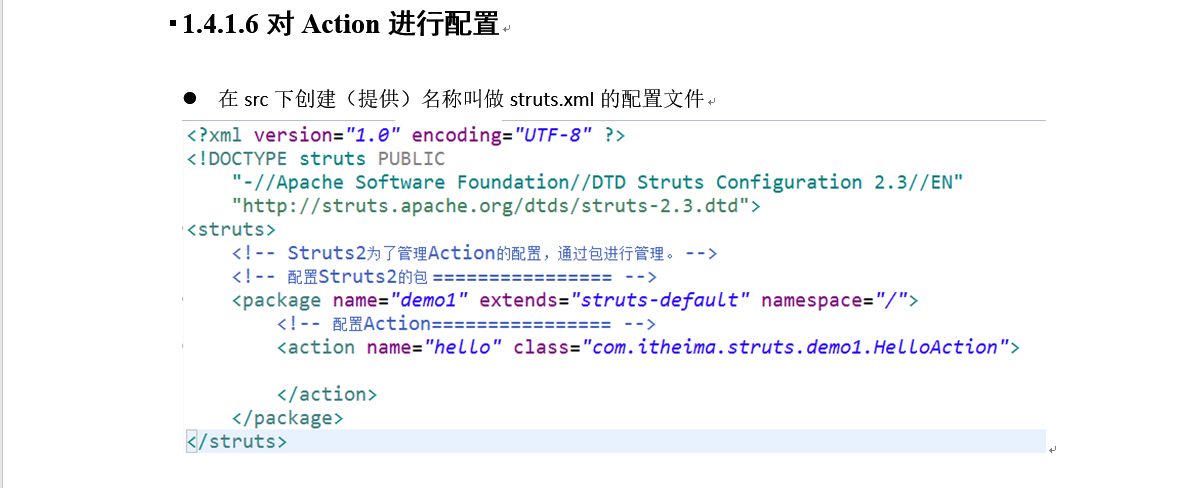
action的name要与访问路径对应。hello.action。

加到tomcat启动 访问:http://localhost:8080/struts2-1/demo1/demo1.jsp

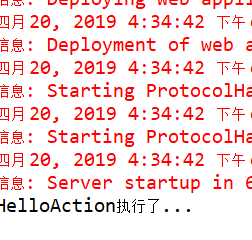

改为success

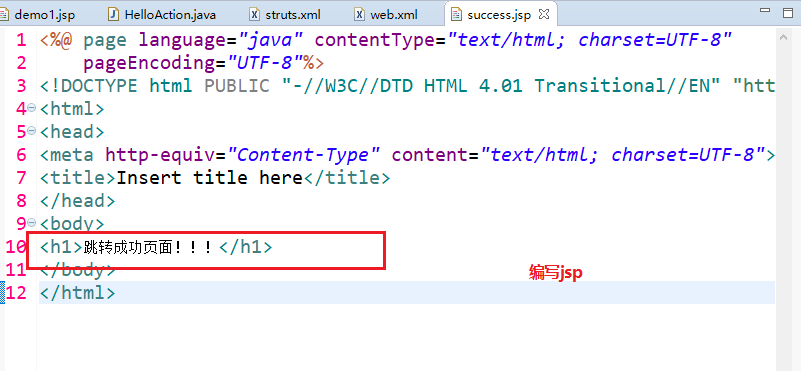
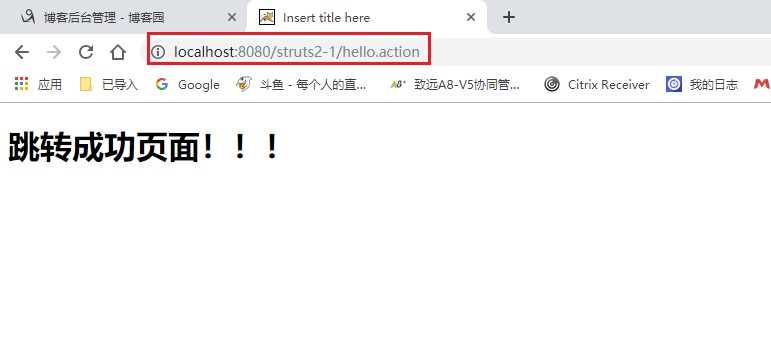
以上。
执行流程见下:

代码:
package com.itheima.struts.demo1;
/**
* Struts2的入门的Action类
* @author jt
*/
public class HelloAction {
/**
* 提供一个方法:
* * 方法签名固定的
* 共有的 返回值是String类型 方法名execute 在这个方法中不能传递参数。
*/
public String execute(){
System.out.println("HelloAction执行了...");
return "success";
}
}
xml:
<?xml version="1.0" encoding="UTF-8" ?> <!DOCTYPE struts PUBLIC "-//Apache Software Foundation//DTD Struts Configuration 2.3//EN" "http://struts.apache.org/dtds/struts-2.3.dtd"> <struts> <!-- Struts2为了管理Action的配置,通过包进行管理。 --> <!-- 配置Struts2的包 ================ --> <package name="demo1" extends="struts-default" namespace="/"> <!-- 配置Action================ --> <action name="hello" class="com.itheima.struts.demo1.HelloAction" > <!-- 配置页面的跳转=========== --> <result name="success">/demo1/success.jsp</result> </action> </package> </struts>
jsp:
<%@ page language="java" contentType="text/html; charset=UTF-8"
pageEncoding="UTF-8"%>
<!DOCTYPE html PUBLIC "-//W3C//DTD HTML 4.01 Transitional//EN" "http://www.w3.org/TR/html4/loose.dtd">
<html>
<head>
<meta http-equiv="Content-Type" content="text/html; charset=UTF-8">
<title>Insert title here</title>
</head>
<body>
<h1>Struts2的入门</h1>
<h3><a href="${ pageContext.request.contextPath }/hello.action">Struts2的入门</a></h3>
</body>
</html>
<%@ page language="java" contentType="text/html; charset=UTF-8" pageEncoding="UTF-8"%> <!DOCTYPE html PUBLIC "-//W3C//DTD HTML 4.01 Transitional//EN" "http://www.w3.org/TR/html4/loose.dtd"> <html> <head> <meta http-equiv="Content-Type" content="text/html; charset=UTF-8"> <title>Insert title here</title> </head> <body> <h1>跳转成功页面!!!</h1> </body> </html>
web.xml:
<?xml version="1.0" encoding="UTF-8"?>
<web-app xmlns:xsi="http://www.w3.org/2001/XMLSchema-instance" xmlns="http://java.sun.com/xml/ns/javaee" xsi:schemaLocation="http://java.sun.com/xml/ns/javaee http://java.sun.com/xml/ns/javaee/web-app_2_5.xsd" id="WebApp_ID" version="2.5">
<display-name>struts2_day01</display-name>
<welcome-file-list>
<welcome-file>index.html</welcome-file>
<welcome-file>index.htm</welcome-file>
<welcome-file>index.jsp</welcome-file>
<welcome-file>default.html</welcome-file>
<welcome-file>default.htm</welcome-file>
<welcome-file>default.jsp</welcome-file>
</welcome-file-list>
<!-- 配置Struts2的核心过滤器 -->
<filter>
<filter-name>struts2</filter-name>
<filter-class>org.apache.struts2.dispatcher.ng.filter.StrutsPrepareAndExecuteFilter</filter-class>
<!-- 修改常量 -->
<!--<init-param> -->
<!--<param-name>struts.action.extension</param-name> -->
<!--<param-value>xyz</param-value> -->
<!--</init-param> -->
</filter>
<filter-mapping>
<filter-name>struts2</filter-name>
<url-pattern>/*</url-pattern>
</filter-mapping>
</web-app>
当用户访问某一个Action的时候,先经过核心过滤器,在核心过滤器中执行一组拦截器(这组拦截器实现部分功能),执行目标Action,根据Action的返回值,进行页面跳转。

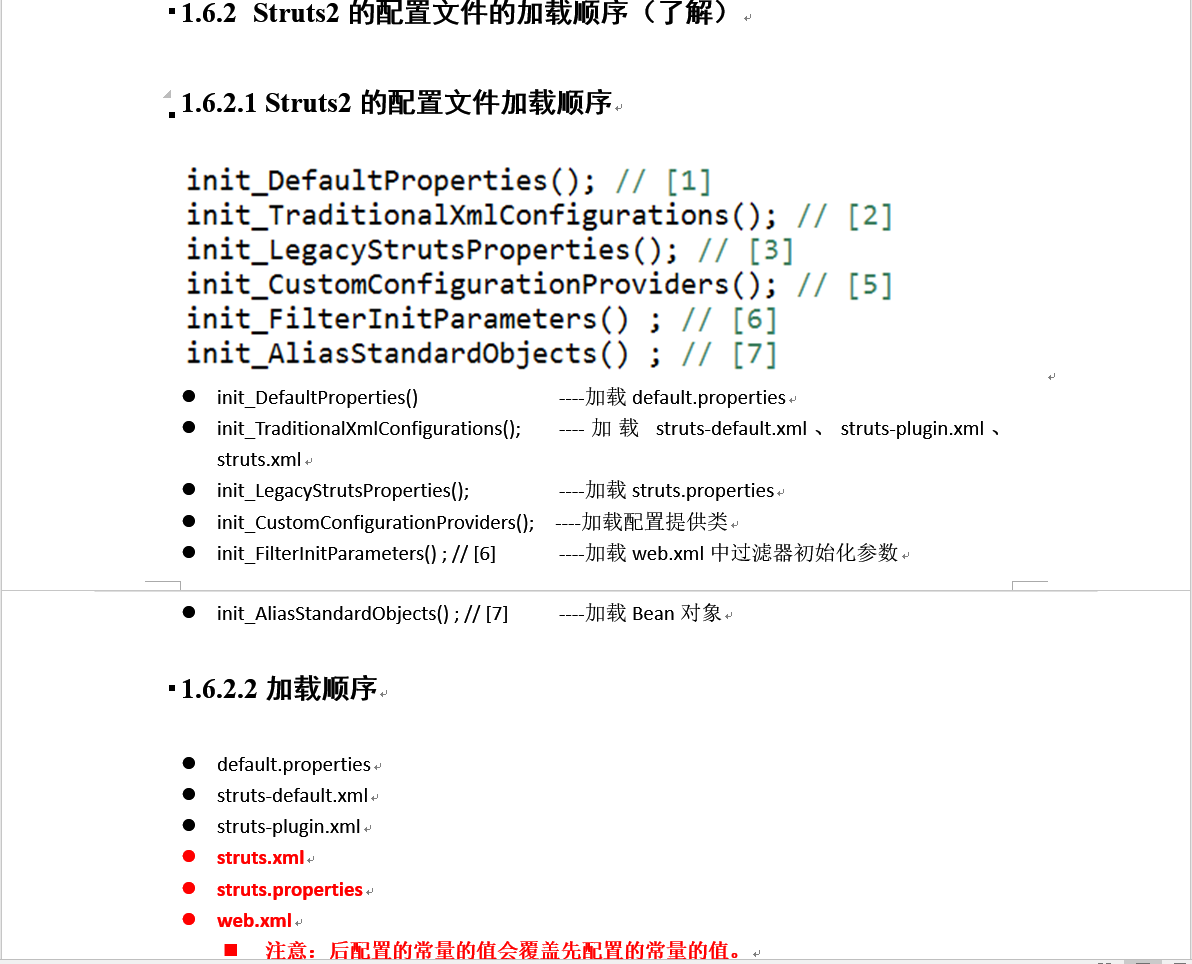


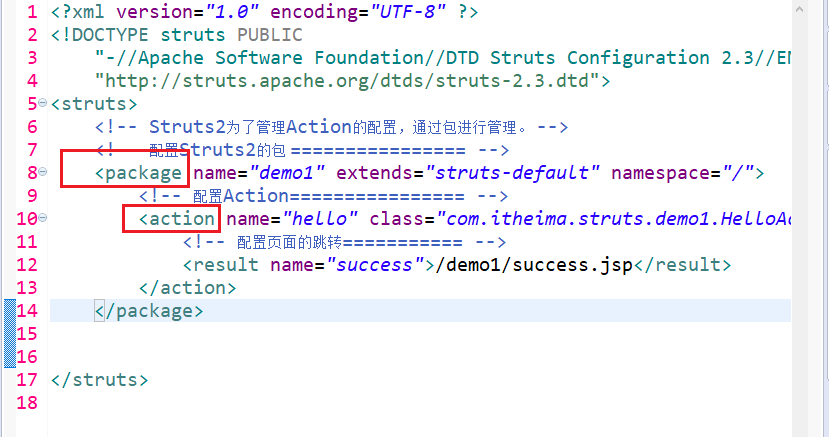

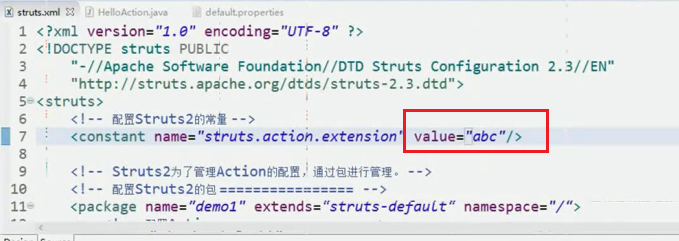
修改为abc后 再用.action访问就失效了 只能用XXX.abc进行访问。
properties需要在src目录下新建一个 但是只能用来修改常量。
web.xml里面是通过过滤器的初始化参数进行修改。
如果三个文件都修改了 那么web.xml里面的会最终生效。这与加载顺序有关 后加载的会覆盖以前的。
虽然如此 但我们习惯于struts.xml中修改。(一般一进入文件就可以看到。)


c此处代码不附上。



此处代码不附。
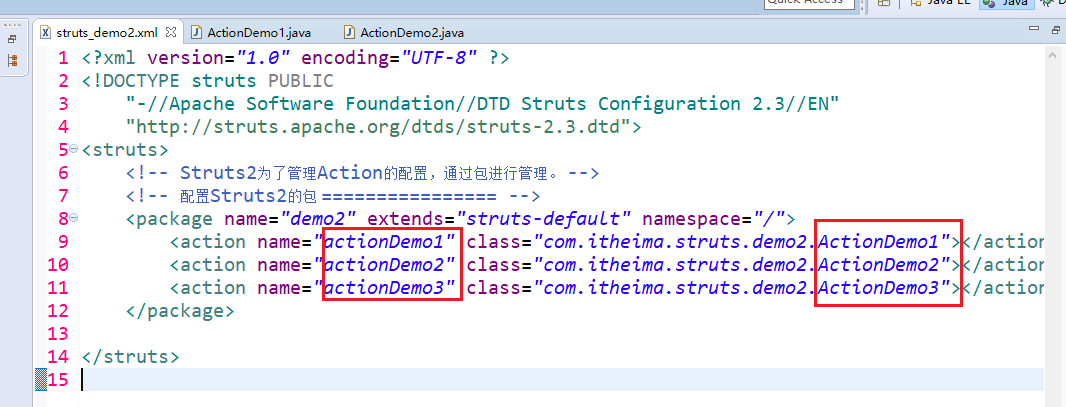

启动访问:http://localhost:8080/struts2-1/actionDemo3.action
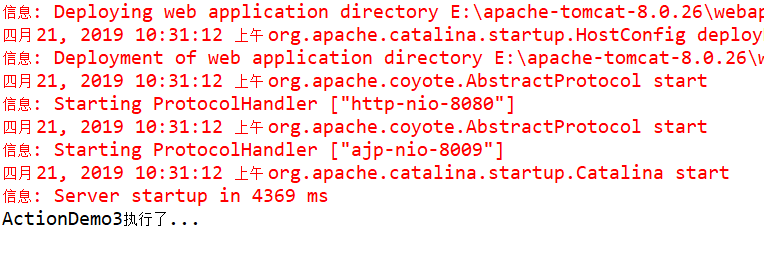
以上三种方式 推荐使用第三种。
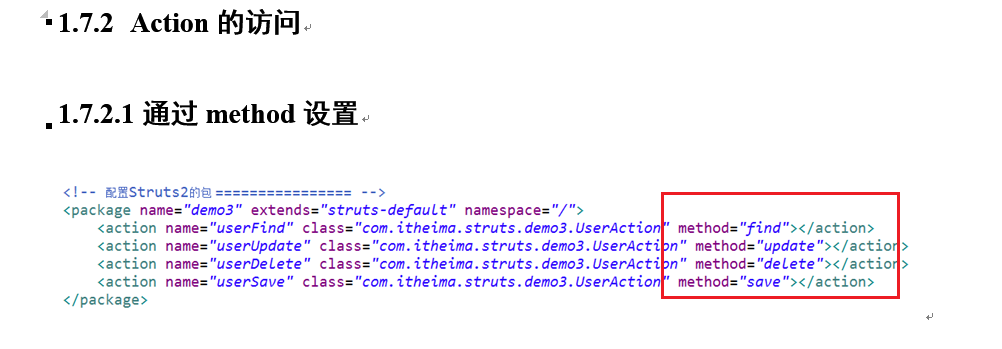
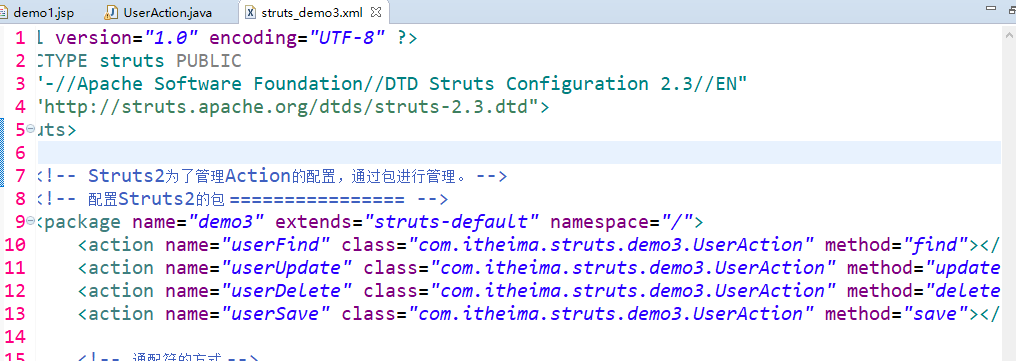
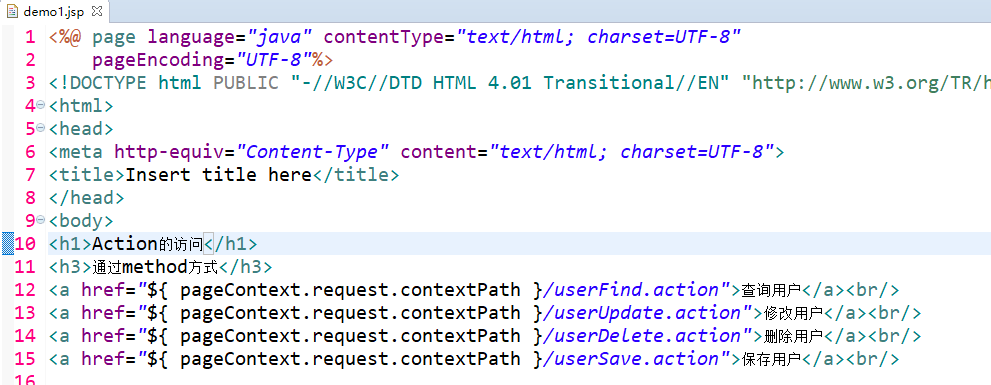
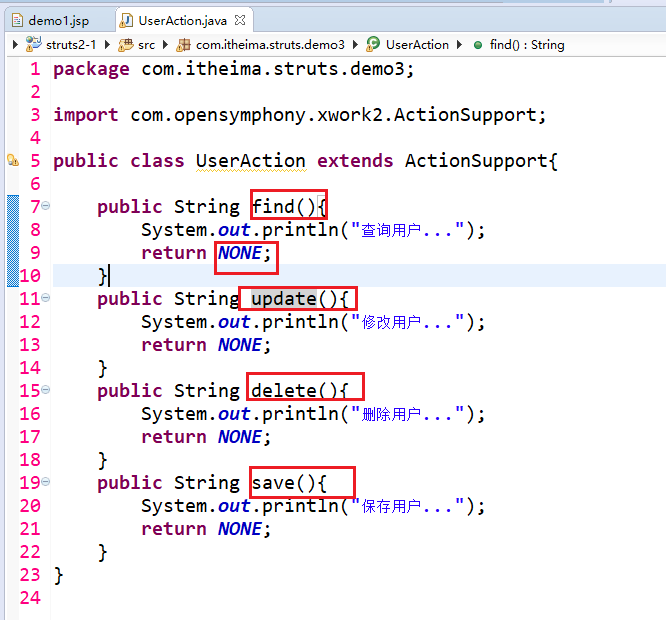

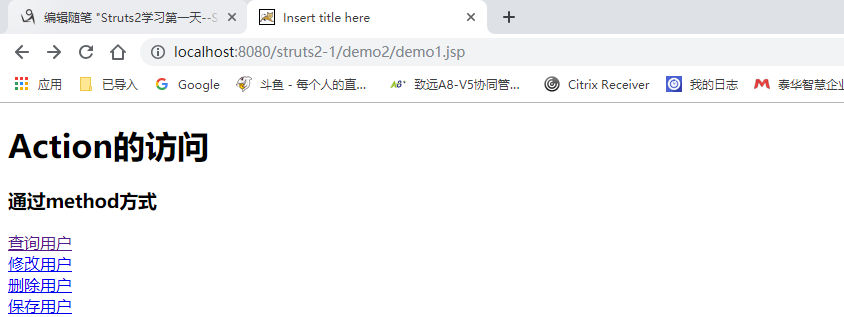
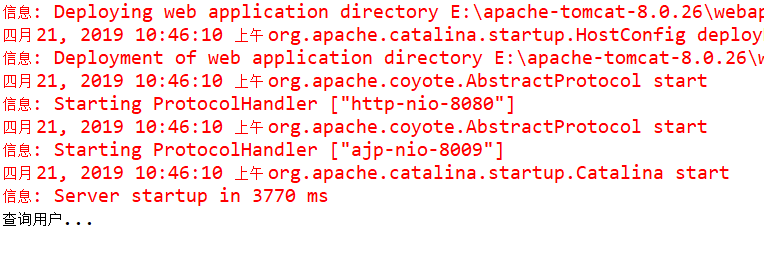


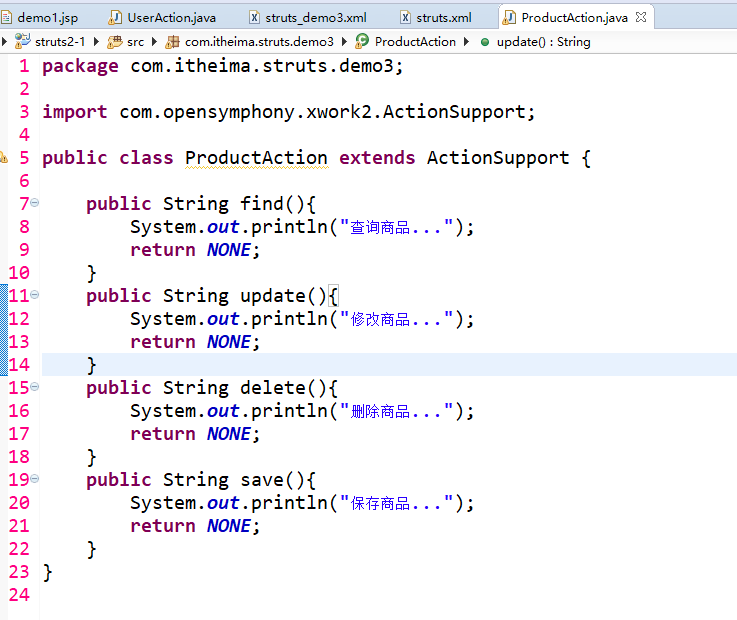
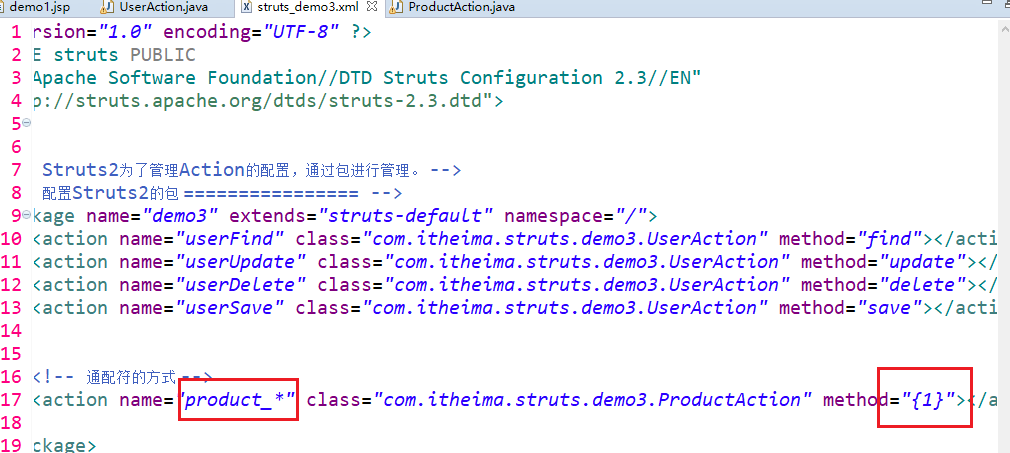
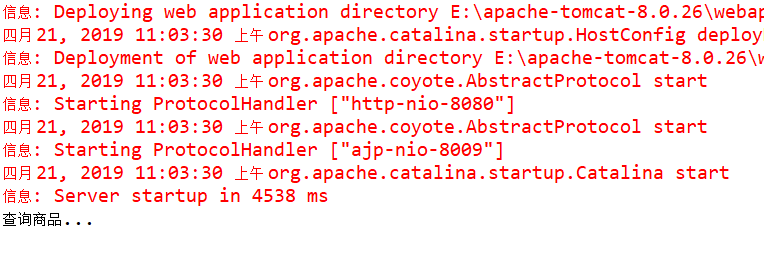





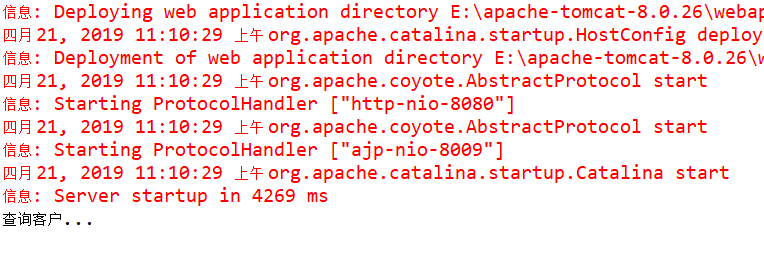
代码如下:

jsp:
<%@ page language="java" contentType="text/html; charset=UTF-8"
pageEncoding="UTF-8"%>
<!DOCTYPE html PUBLIC "-//W3C//DTD HTML 4.01 Transitional//EN" "http://www.w3.org/TR/html4/loose.dtd">
<html>
<head>
<meta http-equiv="Content-Type" content="text/html; charset=UTF-8">
<title>Insert title here</title>
</head>
<body>
<h1>Action的访问</h1>
<h3>通过method方式</h3>
<a href="${ pageContext.request.contextPath }/userFind.action">查询用户</a><br/>
<a href="${ pageContext.request.contextPath }/userUpdate.action">修改用户</a><br/>
<a href="${ pageContext.request.contextPath }/userDelete.action">删除用户</a><br/>
<a href="${ pageContext.request.contextPath }/userSave.action">保存用户</a><br/>
<h3>通过通配符的方式</h3>
<a href="${ pageContext.request.contextPath }/product_find.action">查询商品</a><br/>
<a href="${ pageContext.request.contextPath }/product_update.action">修改商品</a><br/>
<a href="${ pageContext.request.contextPath }/product_delete.action">删除商品</a><br/>
<a href="${ pageContext.request.contextPath }/product_save.action">保存商品</a><br/>
<h3>通过动态方法访问的方式</h3>
<a href="${ pageContext.request.contextPath }/customer!find.action">查询客户</a><br/>
<a href="${ pageContext.request.contextPath }/customer!update.action">修改客户</a><br/>
<a href="${ pageContext.request.contextPath }/customer!delete.action">删除客户</a><br/>
<a href="${ pageContext.request.contextPath }/customer!save.action">保存客户</a><br/>
</body>
</html>
三个action:
package com.itheima.struts.demo3;
import com.opensymphony.xwork2.ActionSupport;
public class UserAction extends ActionSupport{
public String find(){
System.out.println("查询用户...");
return NONE;
}
public String update(){
System.out.println("修改用户...");
return NONE;
}
public String delete(){
System.out.println("删除用户...");
return NONE;
}
public String save(){
System.out.println("保存用户...");
return NONE;
}
}
package com.itheima.struts.demo3;
import com.opensymphony.xwork2.ActionSupport;
public class ProductAction extends ActionSupport {
public String find(){
System.out.println("查询商品...");
return NONE;
}
public String update(){
System.out.println("修改商品...");
return NONE;
}
public String delete(){
System.out.println("删除商品...");
return NONE;
}
public String save(){
System.out.println("保存商品...");
return NONE;
}
}
package com.itheima.struts.demo3;
import com.opensymphony.xwork2.ActionSupport;
public class CustomerAction extends ActionSupport {
public String find(){
System.out.println("查询客户...");
return NONE;
}
public String delete(){
System.out.println("删除客户...");
return NONE;
}
public String update(){
System.out.println("修改客户...");
return NONE;
}
public String save(){
System.out.println("保存客户...");
return NONE;
}
}

见下:
<?xml version="1.0" encoding="UTF-8" ?>
<!DOCTYPE struts PUBLIC
"-//Apache Software Foundation//DTD Struts Configuration 2.3//EN"
"http://struts.apache.org/dtds/struts-2.3.dtd">
<struts>
<!-- 开启动态方法访问 -->
<constant name="struts.enable.DynamicMethodInvocation" value="true"/>
<!-- Struts2为了管理Action的配置,通过包进行管理。 -->
<!-- 配置Struts2的包 ================ -->
<package name="demo3" extends="struts-default" namespace="/">
<action name="userFind" class="com.itheima.struts.demo3.UserAction" method="find"></action>
<action name="userUpdate" class="com.itheima.struts.demo3.UserAction" method="update"></action>
<action name="userDelete" class="com.itheima.struts.demo3.UserAction" method="delete"></action>
<action name="userSave" class="com.itheima.struts.demo3.UserAction" method="save"></action>
<!-- 通配符的方式 -->
<action name="product_*" class="com.itheima.struts.demo3.ProductAction" method="{1}"></action>
<!-- 动态方法访问的方式 -->
<action name="customer" class="com.itheima.struts.demo3.CustomerAction"></action>
</package>
</struts>
struts.xml:
<?xml version="1.0" encoding="UTF-8" ?> <!DOCTYPE struts PUBLIC "-//Apache Software Foundation//DTD Struts Configuration 2.3//EN" "http://struts.apache.org/dtds/struts-2.3.dtd"> <struts> <!-- 配置Struts2的常量 --> <constant name="struts.action.extension" value="action"/> <include file="com/itheima/struts/demo1/struts_demo1.xml"></include> <include file="com/itheima/struts/demo2/struts_demo2.xml"></include> <include file="com/itheima/struts/demo3/struts_demo3.xml"></include> </struts>
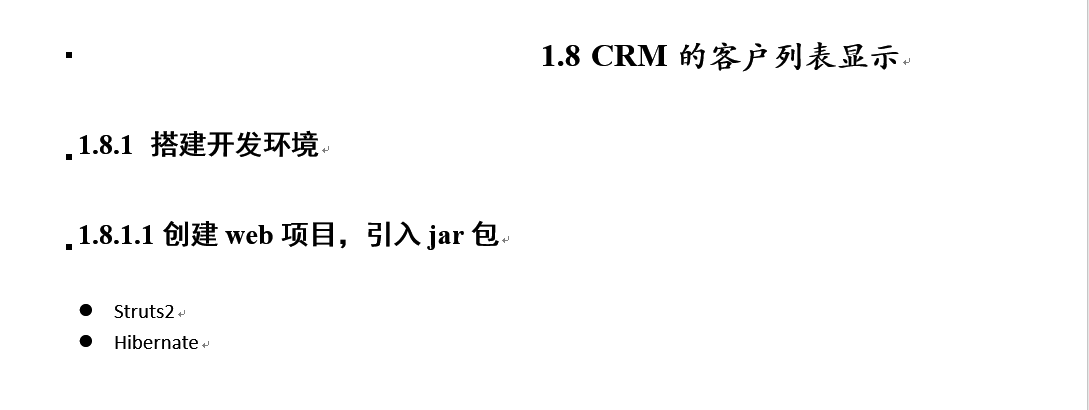

其中有俩jstl的包 standard 和jstl。



CREATE TABLE `cst_customer` ( `cust_id` BIGINT(32) NOT NULL AUTO_INCREMENT COMMENT '客户编号(主键)', `cust_name` VARCHAR(32) NOT NULL COMMENT '客户名称(公司名称)', `cust_source` VARCHAR(32) DEFAULT NULL COMMENT '客户信息来源', `cust_industry` VARCHAR(32) DEFAULT NULL COMMENT '客户所属行业', `cust_level` VARCHAR(32) DEFAULT NULL COMMENT '客户级别', `cust_phone` VARCHAR(64) DEFAULT NULL COMMENT '固定电话', `cust_mobile` VARCHAR(16) DEFAULT NULL COMMENT '移动电话', PRIMARY KEY (`cust_id`) ) ENGINE=INNODB AUTO_INCREMENT=1 DEFAULT CHARSET=utf8;
新建包结构:



在页面menu.html中修改。
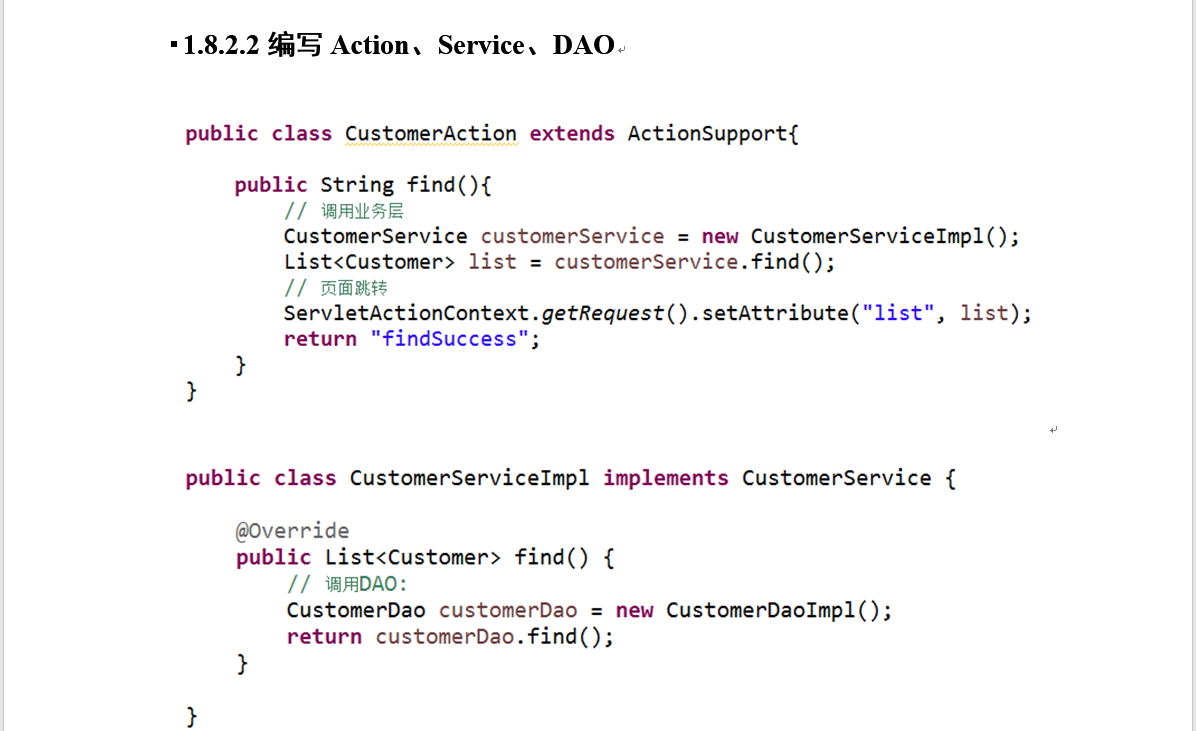

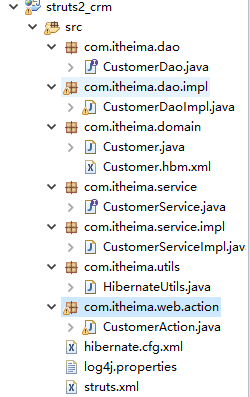
然后引入jstl的包 以便使用。


同时修改jsp。
再在hibeinate映射文件中引入映射

数据库中添加两条数据:

再次启动项目:
http://localhost:8080/struts2_crm/

代码略;